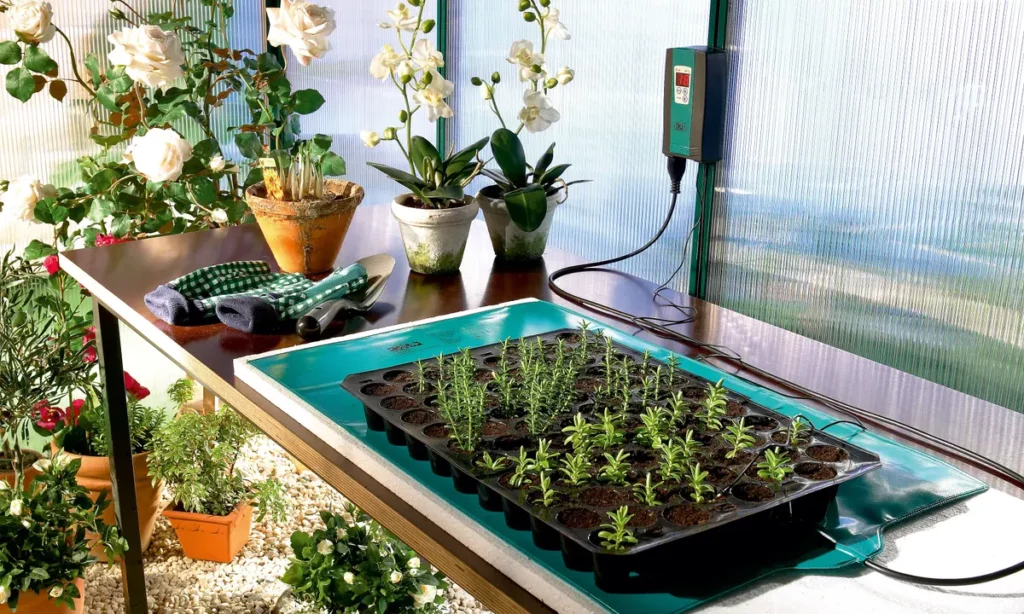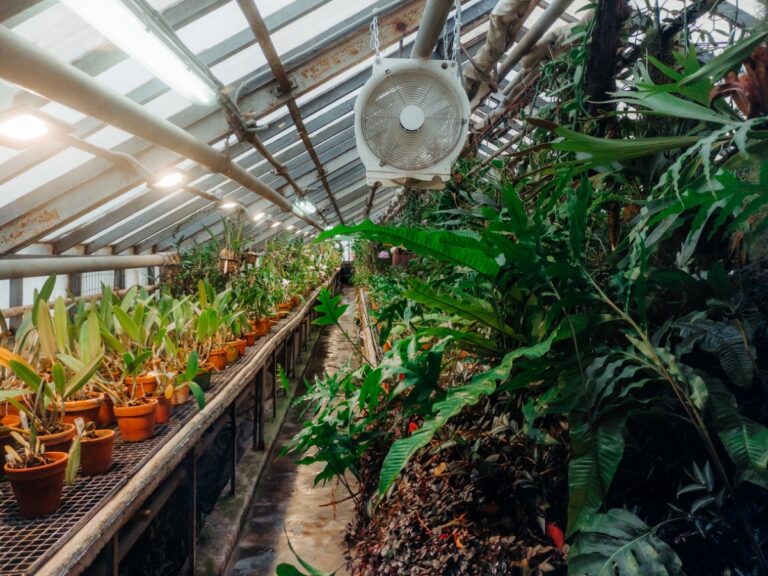Properly heating a plastic greenhouse is essential for creating an optimal plant growing environment. Without adequate heating, plants may suffer from cold temperatures, which can stunt their growth or even result in their death.
Here are the effective tips for properly heating a plastic greenhouse.
- Set the greenhouse heater thermostat to maintain a temperature of around 70°F (21°C).
- Use bubble wrap or thermal curtains to provide insulation, raising the temperature by 5-10°F (3-6°C).
- Position water barrels or bricks inside for thermal mass, which can add 5-10°F (3-6°C) to heat retention.
- Implement a ventilation system to control humidity and prevent temperatures from exceeding 85°F (29°C).
- Consider using a heat lamp or heat mats for specific plants, keeping them around 10-20°F (6-11°C) warmer than the greenhouse’s overall temperature.
How to Heat A Plastic Greenhouse: Consecutive Steps for Keeping Your Plants Thriving in the Cold Weather

Maintaining the right temperature is essential for plants in a plastic greenhouse to thrive. Not only does it provide a conducive environment for growth, but it also offers numerous benefits.
Plants can thrive by ensuring the right temperature, leading to increased yields and healthier crops. Furthermore, it promotes faster germination, protects plants from extreme weather conditions, and prolongs the growing season.
Here are various methods and techniques to heat a plastic greenhouse effectively, enabling you to create an ideal environment for your plants.
Evaluate your Heating needs.
To effectively heat a plastic greenhouse and ensure your plants thrive in cold weather, you must begin by evaluating your heating needs.
a. Assessing Heating Requirements:
- Consider your geographic location. For example, if you live in a region with harsh winters, your heating needs will be more substantial than in milder climates.
- Evaluate the types of plants you are growing. Some plants require higher temperatures than others. Research the specific temperature ranges your plants need to thrive.
- Calculate the greenhouse’s size in square feet (or square meters) to determine the heating capacity required. A general rule of thumb is to provide around 20-30 BTUs (British Thermal Units) per square foot per hour to maintain a comfortable temperature.
b. Determining Ideal Temperature Range:
- Different plants have varying temperature preferences during their growth stages. For instance, many seedlings and young plants thrive in temperatures between 70°F to 75°F (21°C to 24°C).
- Some flowering and fruiting plants may require higher temperatures, around 75°F to 85°F (24°C to 29°C).
- During nighttime or dormancy periods, temperatures can be lowered to save energy while avoiding plant stress. A range of 50°F to 60°F (10°C to 15°C) is often suitable for this purpose.
By carefully assessing your heating needs based on geographic location and plant types, as well as understanding the ideal temperature ranges for your plants at different growth stages.
Consecutively, you can create an effective heating strategy for your plastic greenhouse, ensuring optimal conditions for your plants in cold weather.
Heating options for plastic greenhouse
When it comes to heating plastic greenhouses for optimal plant growth in cold weather, you have several heating options to consider:
a. Electric Heaters:
- Electric heaters are a reliable choice for greenhouse heating.
- Types include fan heaters, radiant heaters, and unit heaters.
- Considerations for choosing the right one include wattage, heating capacity, and energy efficiency.
b. Propane Heaters:
- Propane heaters are popular due to their affordability and convenience.
- Pros include portability and quick heating.
- Cons involve the need for propane tanks, which can add to operating costs.
c. Solar Heaters:
- Solar heaters are eco-friendly, harnessing solar energy to heat your greenhouse.
- They can consist of solar panels or solar air heaters.
- These heaters provide sustainable heating but may require an initial investment in solar equipment.
d. Other Heating Alternatives:
- Geothermal heating uses the earth’s stable temperature to regulate greenhouse temperatures efficiently.
- Biomass heaters burn organic materials like wood chips or pellets for heating, offering a sustainable choice.
Each heating option has benefits and considerations, so selecting the one that aligns with your greenhouse’s size, location, and budget is crucial.
Electric heaters offer precise control, propane heaters are affordable, solar heaters are eco-friendly, and alternative geothermal and biomass heating cater to specific needs.
Choosing the right heating method will help maintain the ideal temperature range for your plants, ensuring they thrive even in cold weather.
Insulation and Energy Efficiency:
a. Importance of Insulation:
- Insulating your plastic greenhouse is crucial to retain heat and reduce energy loss.
- It helps maintain stable temperatures and prevents cold drafts that can harm plants.
b. Tips for Improved Energy Efficiency:
- Seal Gaps: Identify and seal any gaps or cracks in the greenhouse structure to prevent heat from escaping.
- Add Insulation Layers: Install insulation materials like double-layered polyethylene or fiberglass to trap heat.
- Use Thermal Screens or Bubble Wrap: Hang thermal screens or apply bubble wrap to greenhouse walls to create an additional barrier against heat loss.
- Employ Shade Nets: During the hottest months, shade nets can prevent overheating and reduce the need for cooling.
Heat Distribution and Air Circulation:
a. Strategies for Even Heat Distribution:
- Position heaters strategically, such as near the center of the greenhouse, to distribute heat evenly.
- Use reflective materials on the greenhouse walls and ceiling to bounce heat towards plants.
- Consider installing a forced-air heating system that blows warm air evenly across the space.
b. Role of Fans and Vents in Air Circulation:
- Fans play a vital role in maintaining proper air circulation preventing stagnant air and cold spots.
- Both roof and side vents help regulate temperature and humidity by allowing fresh air to enter and hot, moist air to escape.
- Adequate air circulation reduces the risk of humidity-related issues like mold and fungal growth.
By employing these strategies for heat distribution and using fans and vents for efficient air circulation, you can create a well-balanced and healthy environment within your plastic greenhouse, ensuring your plants thrive in cold weather conditions.
Monitoring and Maintaining Temperature:
a. Utilizing Temperature Control Tools:
- Thermometers, such as digital or analog models, are essential for accurate temperature monitoring.
- Thermostats and temperature-controlled devices automate heating systems, maintaining a consistent environment.
b. Importance of Regular Checks and Adjustments:
- Regularly check thermometers and thermostat readings to ensure they align with your plants’ temperature requirements.
- Adjust heating settings as needed to maintain optimal conditions for plant growth, especially during temperature fluctuations.
By employing these monitoring and maintenance practices, you can safeguard your plastic greenhouse and create a stable climate that supports your plants’ well-being in cold weather.
Winter Plant Care Tips:

a. Additional Measures for Winter Protection:
- Consider using frost blankets, which can provide up to 6°F (3.3°C) of frost protection for plants.
- Installing heating cables in the soil can prevent root damage and maintain a favorable root zone temperature, typically around 70°F (21°C).
b. Adjusting Watering and Providing Supplementary Lighting:
- Water less in winter to avoid soaked soil as plants need less moisture then.
- Supplement shorter daylight hours with artificial lighting, providing plants with 12-16 hours of light daily, maintaining a light intensity of 1000-2000 lumens per square foot.
These winter plant care tips, including protective measures and adjustments to watering and lighting, are essential for maintaining a healthy and thriving greenhouse environment during the cold season.
FAQs
Do I need to heat my plastic greenhouse during the winter?
Yes, heating is necessary to maintain a suitable temperature for plants during cold winter months.
What heating options are suitable for a plastic greenhouse?
Electric heaters, propane heaters, or wood-burning stoves are common options. Electric heaters are often the most convenient.
How do I determine the right size heater for my greenhouse?
Calculate the greenhouse’s cubic footage and choose a heater with the appropriate heating capacity, typically measured in BTUs (British Thermal Units).
What’s the ideal temperature range for a heated greenhouse?
Typically, a range of 55°F to 75°F (13°C to 24°C) is suitable for most plants, but this may vary depending on the specific crops you’re growing.
Should I use a thermostat to control the greenhouse heater?
Yes, you should use a thermostat to control the greenhouse heater. Using a thermostat ensures precise temperature control, preventing overheating or underheating.
Can I use heat lamps to warm my plastic greenhouse?
Yes, you can use heat lamps to warm your plastic greenhouse, but ensure they are safely positioned and do not cause overheating or damage to plants.
Are there energy-efficient heating options for a plastic greenhouse?
Yes, there are energy-efficient heating options for a plastic greenhouse, such as using insulated curtains, solar heaters, or energy-efficient electric heaters with thermostats.
Should I insulate my plastic greenhouse to retain heat?
Yes, insulating your plastic greenhouse is recommended to retain heat and create a more stable environment for your plants, especially in cold weather.
What’s the best placement for greenhouse heaters?
Heaters should be placed at ground level to heat the lower part of the greenhouse effectively, allowing warm air to rise.
Can I use alternative methods like compost or radiant floor heating?
Yes, you can use alternative methods like compost heating or radiant floor heating to warm your plastic greenhouse efficiently and sustainably.
Conclusion
In conclusion, properly heating a plastic greenhouse is crucial for creating an optimal environment for plants, especially during cold weather.
Emphasizing the importance of proper heating ensures that plants thrive and grow efficiently.
Plants can withstand freezing temperatures and continue to flourish by maintaining the right temperature. Proper heating methods protect plants and ensure their health and productivity within a plastic greenhouse.

